Key Risks and Challenges for Adopting BIM on Projects - SRM751
VerifiedAdded on 2023/06/07
|7
|1545
|65
Essay
AI Summary
This essay examines the key risks and challenges associated with the adoption of Building Information Modelling (BIM) in the architecture, engineering, and construction (AEC) industry. It delves into both legal and technical risks, including data ownership, copyright issues, and the need for standardized processes. The essay highlights challenges such as the slow adoption of BIM, the lack of standardized BIM contract documents, and the need for well-defined procedures for data exchange. It also addresses management issues, such as who should create and work on BIM models and how operational costs should be distributed. The essay emphasizes the importance of coordinated efforts, risk-sharing among project participants, and the creation of justifiable procedures to promote BIM use. It concludes by emphasizing the potential for BIM to improve project performance, reduce costs, and foster collaboration within project teams, despite the associated risks and challenges. The author suggests that researchers and practitioners must develop effective solutions to overcome these hurdles and fully realize the benefits of BIM.
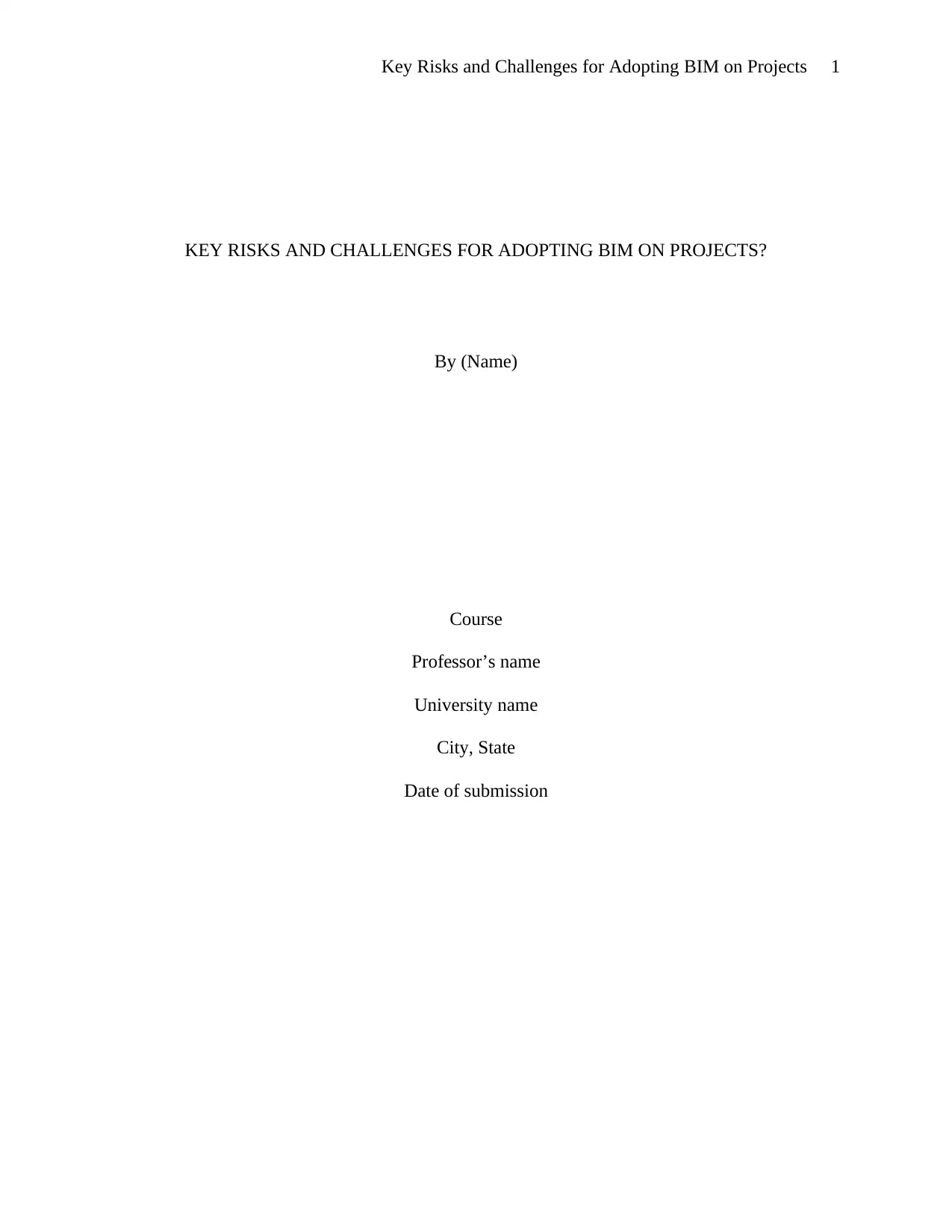
Key Risks and Challenges for Adopting BIM on Projects 1
KEY RISKS AND CHALLENGES FOR ADOPTING BIM ON PROJECTS?
By (Name)
Course
Professor’s name
University name
City, State
Date of submission
KEY RISKS AND CHALLENGES FOR ADOPTING BIM ON PROJECTS?
By (Name)
Course
Professor’s name
University name
City, State
Date of submission
Paraphrase This Document
Need a fresh take? Get an instant paraphrase of this document with our AI Paraphraser
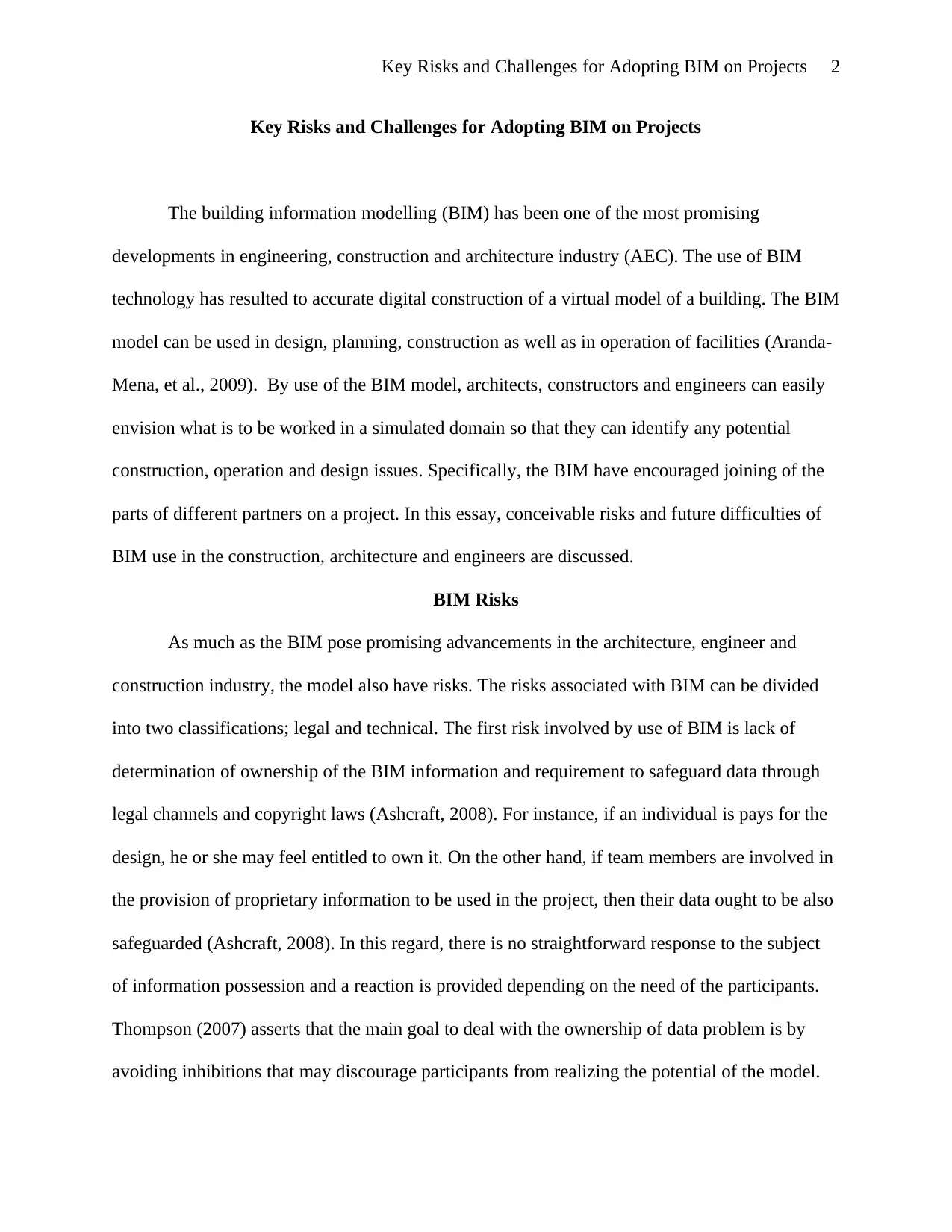
Key Risks and Challenges for Adopting BIM on Projects 2
Key Risks and Challenges for Adopting BIM on Projects
The building information modelling (BIM) has been one of the most promising
developments in engineering, construction and architecture industry (AEC). The use of BIM
technology has resulted to accurate digital construction of a virtual model of a building. The BIM
model can be used in design, planning, construction as well as in operation of facilities (Aranda-
Mena, et al., 2009). By use of the BIM model, architects, constructors and engineers can easily
envision what is to be worked in a simulated domain so that they can identify any potential
construction, operation and design issues. Specifically, the BIM have encouraged joining of the
parts of different partners on a project. In this essay, conceivable risks and future difficulties of
BIM use in the construction, architecture and engineers are discussed.
BIM Risks
As much as the BIM pose promising advancements in the architecture, engineer and
construction industry, the model also have risks. The risks associated with BIM can be divided
into two classifications; legal and technical. The first risk involved by use of BIM is lack of
determination of ownership of the BIM information and requirement to safeguard data through
legal channels and copyright laws (Ashcraft, 2008). For instance, if an individual is pays for the
design, he or she may feel entitled to own it. On the other hand, if team members are involved in
the provision of proprietary information to be used in the project, then their data ought to be also
safeguarded (Ashcraft, 2008). In this regard, there is no straightforward response to the subject
of information possession and a reaction is provided depending on the need of the participants.
Thompson (2007) asserts that the main goal to deal with the ownership of data problem is by
avoiding inhibitions that may discourage participants from realizing the potential of the model.
Key Risks and Challenges for Adopting BIM on Projects
The building information modelling (BIM) has been one of the most promising
developments in engineering, construction and architecture industry (AEC). The use of BIM
technology has resulted to accurate digital construction of a virtual model of a building. The BIM
model can be used in design, planning, construction as well as in operation of facilities (Aranda-
Mena, et al., 2009). By use of the BIM model, architects, constructors and engineers can easily
envision what is to be worked in a simulated domain so that they can identify any potential
construction, operation and design issues. Specifically, the BIM have encouraged joining of the
parts of different partners on a project. In this essay, conceivable risks and future difficulties of
BIM use in the construction, architecture and engineers are discussed.
BIM Risks
As much as the BIM pose promising advancements in the architecture, engineer and
construction industry, the model also have risks. The risks associated with BIM can be divided
into two classifications; legal and technical. The first risk involved by use of BIM is lack of
determination of ownership of the BIM information and requirement to safeguard data through
legal channels and copyright laws (Ashcraft, 2008). For instance, if an individual is pays for the
design, he or she may feel entitled to own it. On the other hand, if team members are involved in
the provision of proprietary information to be used in the project, then their data ought to be also
safeguarded (Ashcraft, 2008). In this regard, there is no straightforward response to the subject
of information possession and a reaction is provided depending on the need of the participants.
Thompson (2007) asserts that the main goal to deal with the ownership of data problem is by
avoiding inhibitions that may discourage participants from realizing the potential of the model.

Key Risks and Challenges for Adopting BIM on Projects 3
Rosenberg (2007) also concludes that the best solution to prevent copyright disagreement is to
set forth ownership rights and responsibilities in the contract documents. In the case of project
team members contributing data that are integrated in the BIM, licensing issues should arise.
Another legal issue to address include control of information entered in the model and
who is in charge of any mistakes. The duty of refreshing building information model data as well
as guaranteeing its exactness has a critical influence on the risks. Besides, the requests for
complicated indemnities by the BIM users and limited disclaimers and warranties offers of
liability by designers should be solved before use of BIM technology (Azhar, et al., 2015).
Additional time is expected to enter data as well as survey the BIM information, which is a cost
in plan and undertaking organization process. As indicated by Thompson (2007), the dangers of
BMI ought to be distinguished and assigned as well as paying the cost of its usage. The
researchers further propose that the coordination of the cost and planning of information ought to
be addressed in the contract (Bryde, et al., 2013). The best method to manage these dangers is to
have, coordinated project delivery contracts in which BMI use dangers are shared among
members.
The responsibility for proper technological interface during the layering of dimensions of
cost and schedule is also an issue. It result from advanced contracting groups which need
subcontractors to avail a point by point plans as well as costs breakdown that are itemized before
the beginning of the project. The general contractor put data together, builds up a master
schedule and cost breakdown for the whole project. When both of them utilize similar software,
the incorporation can be fluid. One of the ways to deal with this is to collaborate and share the
risk of using BMI among project participants.
Rosenberg (2007) also concludes that the best solution to prevent copyright disagreement is to
set forth ownership rights and responsibilities in the contract documents. In the case of project
team members contributing data that are integrated in the BIM, licensing issues should arise.
Another legal issue to address include control of information entered in the model and
who is in charge of any mistakes. The duty of refreshing building information model data as well
as guaranteeing its exactness has a critical influence on the risks. Besides, the requests for
complicated indemnities by the BIM users and limited disclaimers and warranties offers of
liability by designers should be solved before use of BIM technology (Azhar, et al., 2015).
Additional time is expected to enter data as well as survey the BIM information, which is a cost
in plan and undertaking organization process. As indicated by Thompson (2007), the dangers of
BMI ought to be distinguished and assigned as well as paying the cost of its usage. The
researchers further propose that the coordination of the cost and planning of information ought to
be addressed in the contract (Bryde, et al., 2013). The best method to manage these dangers is to
have, coordinated project delivery contracts in which BMI use dangers are shared among
members.
The responsibility for proper technological interface during the layering of dimensions of
cost and schedule is also an issue. It result from advanced contracting groups which need
subcontractors to avail a point by point plans as well as costs breakdown that are itemized before
the beginning of the project. The general contractor put data together, builds up a master
schedule and cost breakdown for the whole project. When both of them utilize similar software,
the incorporation can be fluid. One of the ways to deal with this is to collaborate and share the
risk of using BMI among project participants.
⊘ This is a preview!⊘
Do you want full access?
Subscribe today to unlock all pages.

Trusted by 1+ million students worldwide
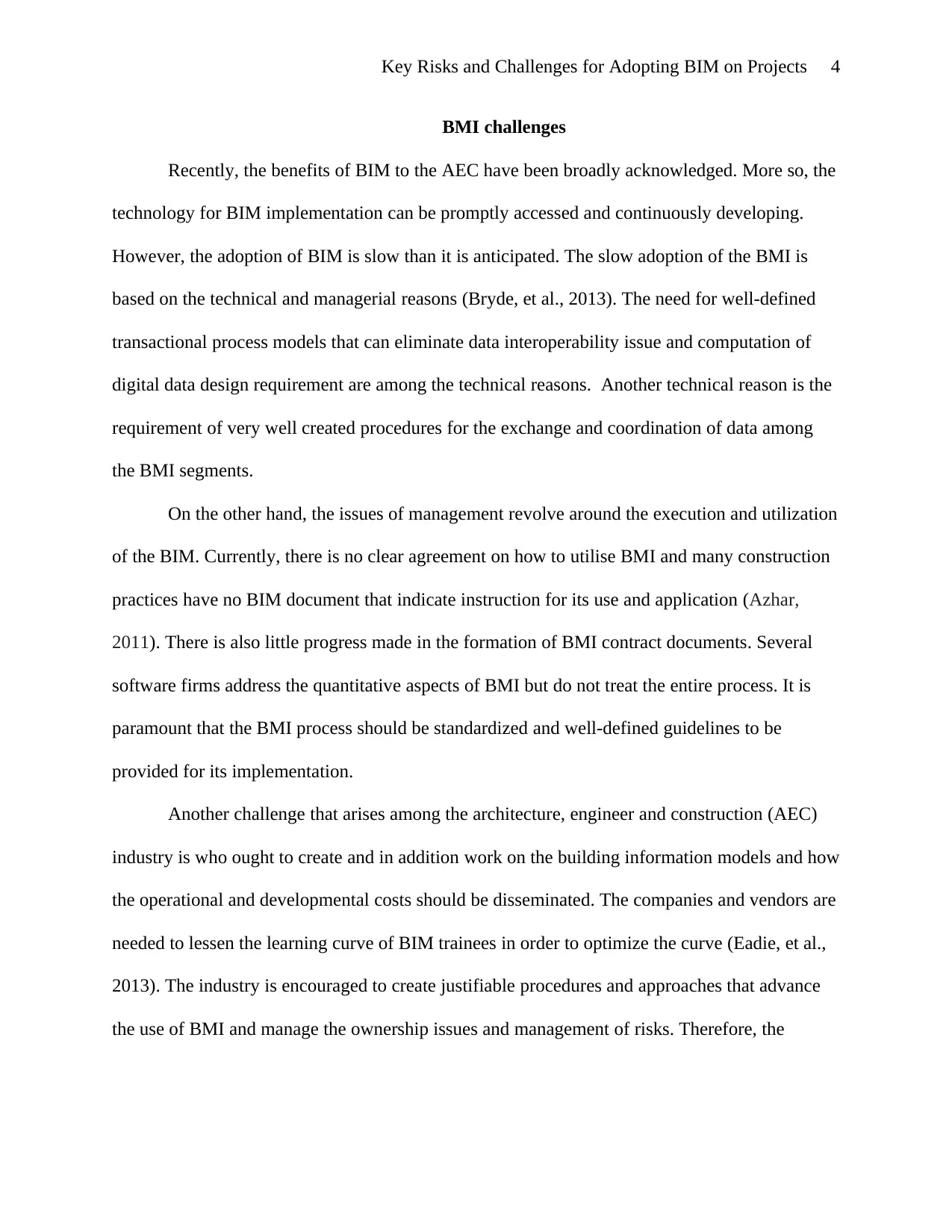
Key Risks and Challenges for Adopting BIM on Projects 4
BMI challenges
Recently, the benefits of BIM to the AEC have been broadly acknowledged. More so, the
technology for BIM implementation can be promptly accessed and continuously developing.
However, the adoption of BIM is slow than it is anticipated. The slow adoption of the BMI is
based on the technical and managerial reasons (Bryde, et al., 2013). The need for well-defined
transactional process models that can eliminate data interoperability issue and computation of
digital data design requirement are among the technical reasons. Another technical reason is the
requirement of very well created procedures for the exchange and coordination of data among
the BMI segments.
On the other hand, the issues of management revolve around the execution and utilization
of the BIM. Currently, there is no clear agreement on how to utilise BMI and many construction
practices have no BIM document that indicate instruction for its use and application (Azhar,
2011). There is also little progress made in the formation of BMI contract documents. Several
software firms address the quantitative aspects of BMI but do not treat the entire process. It is
paramount that the BMI process should be standardized and well-defined guidelines to be
provided for its implementation.
Another challenge that arises among the architecture, engineer and construction (AEC)
industry is who ought to create and in addition work on the building information models and how
the operational and developmental costs should be disseminated. The companies and vendors are
needed to lessen the learning curve of BIM trainees in order to optimize the curve (Eadie, et al.,
2013). The industry is encouraged to create justifiable procedures and approaches that advance
the use of BMI and manage the ownership issues and management of risks. Therefore, the
BMI challenges
Recently, the benefits of BIM to the AEC have been broadly acknowledged. More so, the
technology for BIM implementation can be promptly accessed and continuously developing.
However, the adoption of BIM is slow than it is anticipated. The slow adoption of the BMI is
based on the technical and managerial reasons (Bryde, et al., 2013). The need for well-defined
transactional process models that can eliminate data interoperability issue and computation of
digital data design requirement are among the technical reasons. Another technical reason is the
requirement of very well created procedures for the exchange and coordination of data among
the BMI segments.
On the other hand, the issues of management revolve around the execution and utilization
of the BIM. Currently, there is no clear agreement on how to utilise BMI and many construction
practices have no BIM document that indicate instruction for its use and application (Azhar,
2011). There is also little progress made in the formation of BMI contract documents. Several
software firms address the quantitative aspects of BMI but do not treat the entire process. It is
paramount that the BMI process should be standardized and well-defined guidelines to be
provided for its implementation.
Another challenge that arises among the architecture, engineer and construction (AEC)
industry is who ought to create and in addition work on the building information models and how
the operational and developmental costs should be disseminated. The companies and vendors are
needed to lessen the learning curve of BIM trainees in order to optimize the curve (Eadie, et al.,
2013). The industry is encouraged to create justifiable procedures and approaches that advance
the use of BMI and manage the ownership issues and management of risks. Therefore, the
Paraphrase This Document
Need a fresh take? Get an instant paraphrase of this document with our AI Paraphraser
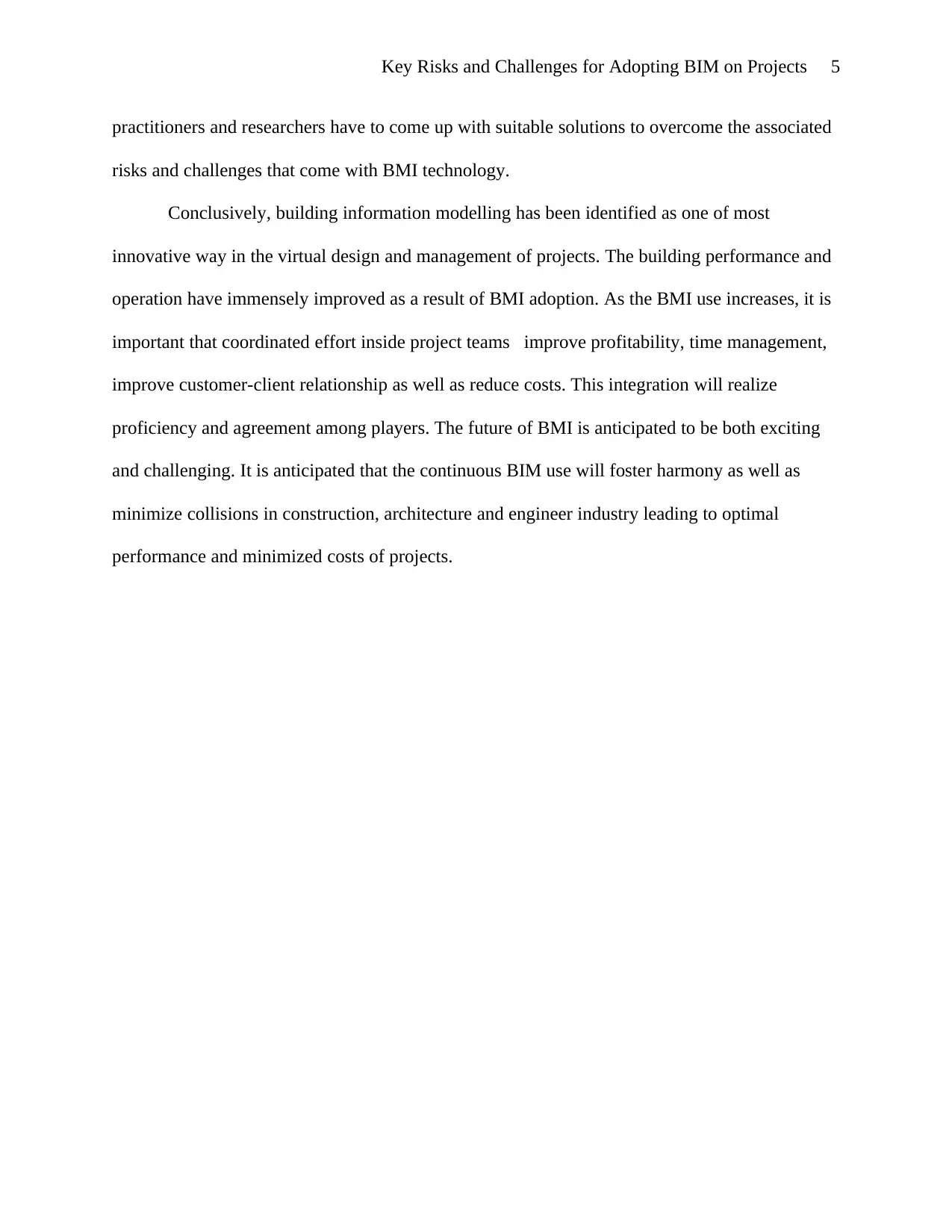
Key Risks and Challenges for Adopting BIM on Projects 5
practitioners and researchers have to come up with suitable solutions to overcome the associated
risks and challenges that come with BMI technology.
Conclusively, building information modelling has been identified as one of most
innovative way in the virtual design and management of projects. The building performance and
operation have immensely improved as a result of BMI adoption. As the BMI use increases, it is
important that coordinated effort inside project teams improve profitability, time management,
improve customer-client relationship as well as reduce costs. This integration will realize
proficiency and agreement among players. The future of BMI is anticipated to be both exciting
and challenging. It is anticipated that the continuous BIM use will foster harmony as well as
minimize collisions in construction, architecture and engineer industry leading to optimal
performance and minimized costs of projects.
practitioners and researchers have to come up with suitable solutions to overcome the associated
risks and challenges that come with BMI technology.
Conclusively, building information modelling has been identified as one of most
innovative way in the virtual design and management of projects. The building performance and
operation have immensely improved as a result of BMI adoption. As the BMI use increases, it is
important that coordinated effort inside project teams improve profitability, time management,
improve customer-client relationship as well as reduce costs. This integration will realize
proficiency and agreement among players. The future of BMI is anticipated to be both exciting
and challenging. It is anticipated that the continuous BIM use will foster harmony as well as
minimize collisions in construction, architecture and engineer industry leading to optimal
performance and minimized costs of projects.
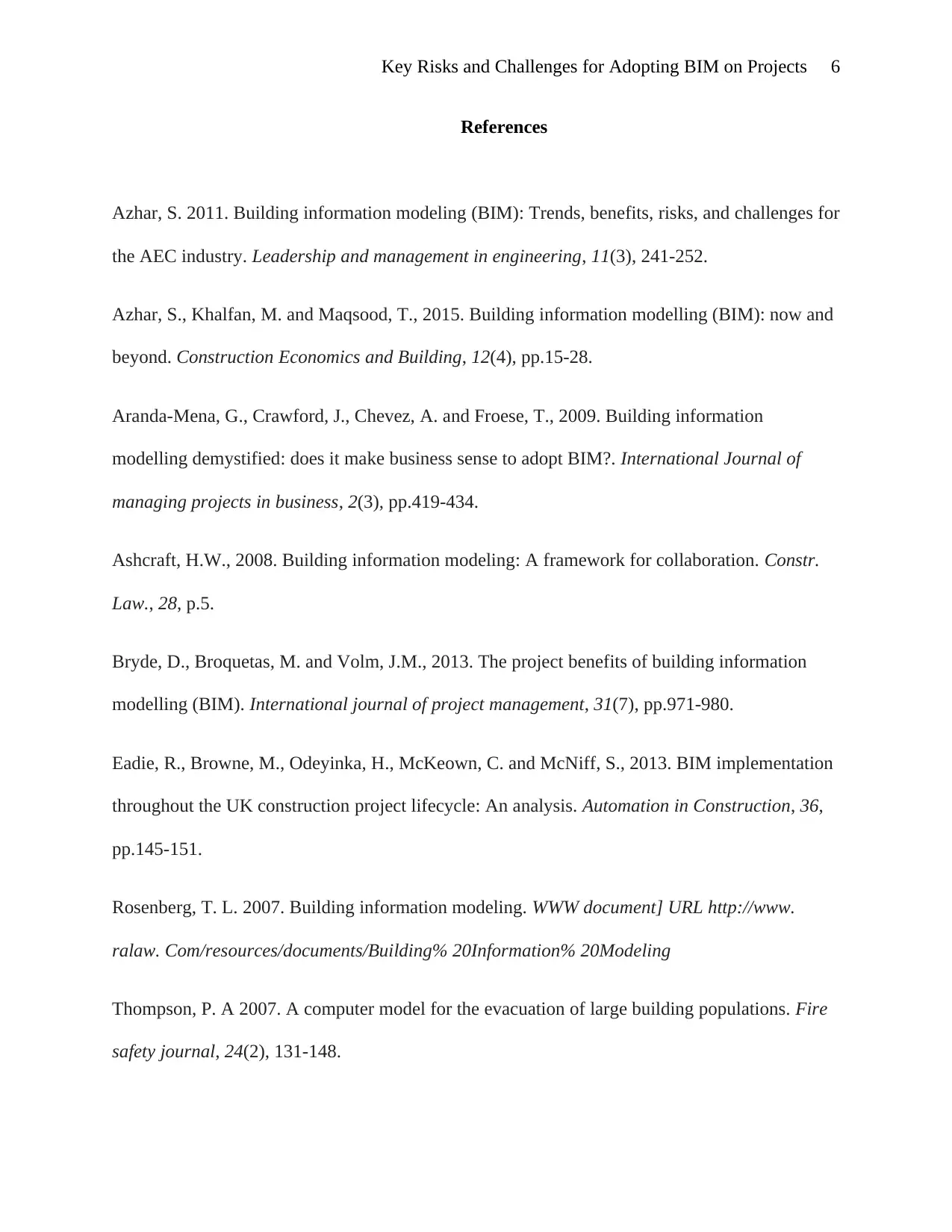
Key Risks and Challenges for Adopting BIM on Projects 6
References
Azhar, S. 2011. Building information modeling (BIM): Trends, benefits, risks, and challenges for
the AEC industry. Leadership and management in engineering, 11(3), 241-252.
Azhar, S., Khalfan, M. and Maqsood, T., 2015. Building information modelling (BIM): now and
beyond. Construction Economics and Building, 12(4), pp.15-28.
Aranda-Mena, G., Crawford, J., Chevez, A. and Froese, T., 2009. Building information
modelling demystified: does it make business sense to adopt BIM?. International Journal of
managing projects in business, 2(3), pp.419-434.
Ashcraft, H.W., 2008. Building information modeling: A framework for collaboration. Constr.
Law., 28, p.5.
Bryde, D., Broquetas, M. and Volm, J.M., 2013. The project benefits of building information
modelling (BIM). International journal of project management, 31(7), pp.971-980.
Eadie, R., Browne, M., Odeyinka, H., McKeown, C. and McNiff, S., 2013. BIM implementation
throughout the UK construction project lifecycle: An analysis. Automation in Construction, 36,
pp.145-151.
Rosenberg, T. L. 2007. Building information modeling. WWW document] URL http://www.
ralaw. Com/resources/documents/Building% 20Information% 20Modeling
Thompson, P. A 2007. A computer model for the evacuation of large building populations. Fire
safety journal, 24(2), 131-148.
References
Azhar, S. 2011. Building information modeling (BIM): Trends, benefits, risks, and challenges for
the AEC industry. Leadership and management in engineering, 11(3), 241-252.
Azhar, S., Khalfan, M. and Maqsood, T., 2015. Building information modelling (BIM): now and
beyond. Construction Economics and Building, 12(4), pp.15-28.
Aranda-Mena, G., Crawford, J., Chevez, A. and Froese, T., 2009. Building information
modelling demystified: does it make business sense to adopt BIM?. International Journal of
managing projects in business, 2(3), pp.419-434.
Ashcraft, H.W., 2008. Building information modeling: A framework for collaboration. Constr.
Law., 28, p.5.
Bryde, D., Broquetas, M. and Volm, J.M., 2013. The project benefits of building information
modelling (BIM). International journal of project management, 31(7), pp.971-980.
Eadie, R., Browne, M., Odeyinka, H., McKeown, C. and McNiff, S., 2013. BIM implementation
throughout the UK construction project lifecycle: An analysis. Automation in Construction, 36,
pp.145-151.
Rosenberg, T. L. 2007. Building information modeling. WWW document] URL http://www.
ralaw. Com/resources/documents/Building% 20Information% 20Modeling
Thompson, P. A 2007. A computer model for the evacuation of large building populations. Fire
safety journal, 24(2), 131-148.
⊘ This is a preview!⊘
Do you want full access?
Subscribe today to unlock all pages.

Trusted by 1+ million students worldwide

Key Risks and Challenges for Adopting BIM on Projects 7
.
.
1 out of 7
Related Documents
Your All-in-One AI-Powered Toolkit for Academic Success.
+13062052269
info@desklib.com
Available 24*7 on WhatsApp / Email
![[object Object]](/_next/static/media/star-bottom.7253800d.svg)
Unlock your academic potential
Copyright © 2020–2025 A2Z Services. All Rights Reserved. Developed and managed by ZUCOL.





